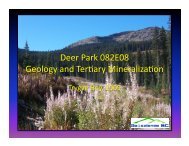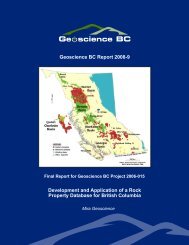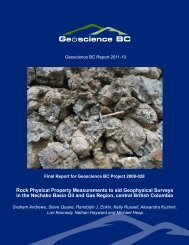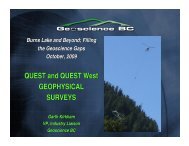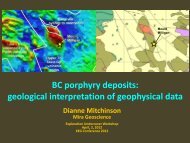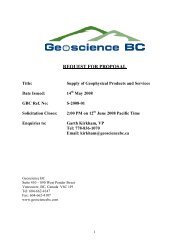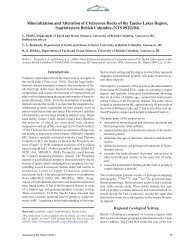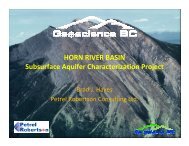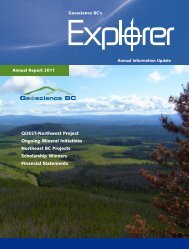Notes Accompanying Original Release of Maps - Geoscience BC
Notes Accompanying Original Release of Maps - Geoscience BC
Notes Accompanying Original Release of Maps - Geoscience BC
- No tags were found...
You also want an ePaper? Increase the reach of your titles
YUMPU automatically turns print PDFs into web optimized ePapers that Google loves.
Metallogenesis <strong>of</strong> the Iskut River Area, Northwestern B.C. --- Regional maps, Lewis<br />
contact. Henderson et al. (1992) placed the unit<br />
between the two groups; the present inclusion within<br />
the Hazelton Group is based on the conformable<br />
relationship with overlying rocks and the <strong>of</strong>ten<br />
unconformably contact with Stuhini Group strata.<br />
Lithology:<br />
The Jack Formation is a lithologically varied<br />
sequence <strong>of</strong> sedimentary rocks which overlies Stuhini<br />
Group strata. Best reference sections <strong>of</strong> the Jack<br />
Formation occur at the Bruce Glacier/Jack Glacier<br />
area, south <strong>of</strong> John Peaks, and near Eskay Creek. At<br />
Bruce and Jack glaciers, the formation consists <strong>of</strong> a<br />
thin conglomerate containing clasts <strong>of</strong> subjacent Stuhini<br />
Group turbiditic mudstones and siltstone (Henderson<br />
et al., 1992). Trough cross stratification and<br />
channelized sandstone and conglomerate layers are<br />
common. In one location, a 2-3 m thick welded,<br />
intermediate composition pyroclastic flow deposit is<br />
interstratified with these clastic rocks. Overlying the<br />
basal sequence are fossiliferous limy sandstone and<br />
siltstone, and thinly to medium bedded, locally phyllitic,<br />
turbiditic siltstones and interbedded sandstones, up to<br />
several hundred metres thick. There is a general<br />
transition southward towards John Peaks towards a<br />
thicker basal conglomerate and sandstone, and a<br />
thinner calcareous and turbiditic component. At the<br />
reference section south <strong>of</strong> John Peaks and on the ridge<br />
extending east from Unuk Finger, the Jack Formation<br />
consists entirely <strong>of</strong> conglomerate and sandstone. Well<br />
rounded granitoid cobbles are diagnostic, typically<br />
comprising up to 50% <strong>of</strong> the clasts. West <strong>of</strong> the Unuk<br />
River in the Eskay Creek area, Jack Formation rocks<br />
comprise several hundred metres <strong>of</strong> thickly bedded<br />
to massive wackes with local conglomeratic lenses<br />
and cross-stratified intervals.<br />
At Brucejack Lake, thick sequences <strong>of</strong><br />
sandstones to cobble conglomerates have been<br />
assigned to the Jack Formation, although age data are<br />
lacking and contacts are ambiguous. In the southern<br />
Iskut River area near the Salmon Glacier, Alldrick (<br />
1991) describes thick siltstone intervals which may<br />
be finer-grained equivalents to Jack Formation to the<br />
north. These siltstones, classified as part <strong>of</strong> the Unuk<br />
River Formation by Alldrick, contain faunal<br />
assemblages <strong>of</strong> similar age to assemblages collected<br />
near Eskay Creek from the Jack Formation<br />
(Anderson, 1993).<br />
Contact relationships:<br />
The basal contact <strong>of</strong> the Jack Formation is well<br />
exposed at the Jack Glacier and south <strong>of</strong> John Peaks<br />
as a sharp, angular unconformity. Along strike from<br />
these localities, the contact is less distinct and bedding<br />
is concordant with underlying rocks. However, the<br />
unit can usually be recognized on the basis <strong>of</strong> the<br />
cobble conglomerate beds at its base. In the Treaty<br />
Glacier area to the east, the contact occurs at a<br />
concordant transition from Stuhini Group volcanic<br />
conglomerates to Jack Formation interstratified coarse<br />
sandstone and conglomerate.<br />
No rocks correlative to the Jack Formation have<br />
been identified in the Johnny Mountain area, although<br />
the Stuhini Group/Hazelton Group contact is clearly<br />
defined as a sharp angular unconformity. In this area,<br />
lowest Hazelton Group rocks consist <strong>of</strong> volcanic and<br />
epiclastic strata correlated with the Betty Creek<br />
Formation.<br />
Age:<br />
Fossil assemblages collected from the Jack<br />
Formation in the Unuk River indicate a Lower Jurassic<br />
age. Well-preserved ammonites Paracalocerous and<br />
Badouxia Canadensis occur in the Eskay Creek<br />
reference section and also near Treaty Glacier, and<br />
are diagnostic <strong>of</strong> an Upper Hettangian to Lower<br />
Sinemurian age. Unconformably underlying Stuhini<br />
Group turbiditic siltstone to mudstone in this area<br />
contain Upper Norian Monotis cf subcicularis<br />
bivalves, providing a maximum age constraint. Upper<br />
biostratigraphic age limits are provided by Upper<br />
Pliensbachian ammonite collections from the Betty<br />
Creek Formation near Eskay Creek and near John<br />
Peaks.<br />
Isotopic age constraints from bounding units<br />
corroborate an Early Jurassic age. Dacitic crystal tuff<br />
in the underlying Stuhini Group at John Peaks yields a<br />
U-Pb zircon date <strong>of</strong> 215-220 Ma (V. McNicoll<br />
reported in Anderson, 1993), and a granitoid clast from<br />
the Jack Formation in this same section is dated at<br />
about 225 Ma. U-Pb zircon dates from the overlying<br />
Betty Creek Formation are as old as 193 ± 1 Ma (M.L.<br />
Bevier, pers. comm., 1994).<br />
Betty Creek Formation<br />
Lower Jurassic volcanic and volcaniclastic strata<br />
have been problematic for workers in the Iskut River<br />
area, and stratigraphic nomenclature has been<br />
unevenly applied (see Lewis et al., this volume). Most<br />
studies in the area assign intermediate composition<br />
rocks in this interval to either the Betty Creek<br />
Formation or the Unuk River Formation as defined<br />
78





